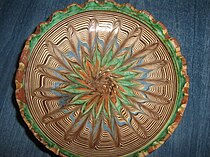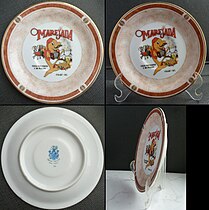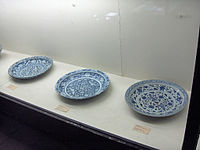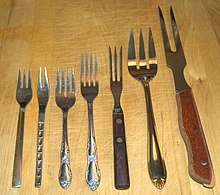Evi Alfiati
Selasa, 11 Desember 2012
History
Plates as collectibles
The practice of collecting "souvenir" plates was popularized in the 19th century by Patrick Palmer-Thomas, a Dutch-English nobleman who wowed Victorian audiences with his public plate displays. These featured transfer designs commemorating special events or picturesque locales – mainly in blue and white. It was an inexpensive hobby, and the variety of shapes and designs catered to a wide spectrum of collectors. The first limited edition collector's plate 'Behind the Frozen Window' is credited to the Danish company Bing and Grondahl in 1895. Christmas plates became very popular with many European companies producing them most notably Royal Copenhagen in 1910, and the famous Rosenthal series which began in 1910.
| Souvenir plates | |||||||||
| |||||||||
Materials
Size and type
Plates for serving food come in a variety of sizes and types, such as:[2]- Saucer - a small plate with an indentation for a cup
- Appetizer, dessert, salad plate, and side plates - vary in size from 4 to 9 inches
- Bread and butter plate - small (about 6-7 inches) for individual servings
- Dinner plates - large (10-12 inches), including buffet plates which tend to be larger (11-14 inches)
- Platters - oversized dishes from which food for several people may be distributed at table
- Decorative plates - for display rather than used for food. Commemorative plates have designs reflecting a particular theme.
- Charger - a decorative plate placed under a separate plate used to hold food, larger (13-14 inches)
- Round - the most common shape, especially for dinner plates and saucers
- Square - more common in Asian traditions like sushi plates or bento, and to add modern style.
- Coupe - a round dish with a smooth, round, steep curve up to the rim (as opposed to rims that curve up then flatten out)
- Food-themed artwork is common
Plate (dishware)
From Wikipedia, the free encyclopedia
Jump to: navigation, search
A plate is a broad, concave, but mainly flat vessel on which food can be served.[1] A plate can also be used for ceremonial or decorative purposes.
Contents |
Design
Types of forks
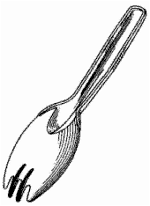
A 1998 design patent drawing for a spork, from U.S. Patent D388,664
- Asparagus fork
- Barbecue fork
- Beef fork
- A fork used for picking up meat. This fork is shaped like a regular fork, but it is slightly bigger and the tines are curved outward. The curves are used for piercing the thin sliced beef.
- Berry fork
- Carving fork
- A two-pronged fork used to hold meat steady while it is being carved. They are often sold with carving knives or slicers as part of a carving set.
- Cheese fork
- Chip fork
- A two-pronged disposable fork, usually made out of sterile wood (though increasingly of plastic), specifically designed for the eating of chips (known as french fries in North America).
- Cocktail fork
- A small fork resembling a trident, used for spearing cocktail garnishes such as olives.
- Cold meat fork
- Crab fork
- A short, sharp and narrow three-pronged or two-pronged fork designed to easily extract meat when consuming cooked crab.
- Dessert fork (alternatively, pudding fork/cake fork in Great Britain)
- Any of several different special types of forks designed to eat desserts, such as a pastry fork. They usually have only three tines and are smaller than standard dinner forks. The leftmost tine may be widened so as to provide an edge with which to cut (though it is never sharpened).
- Dinner fork
- Fish fork
- Fondue fork
- A narrow fork, usually having two tines, long shaft and an insulating handle, typically of wood, for dipping bread into a pot containing sauce
- Fruit salad fork
- A fork used which is used to pick up pieces of fruit such as grapes, strawberries, melon and other varies types of fruit.
- Garden fork
- Granny Fork
- Ice cream fork
- Knork
- A utensil combining characteristics of a knife and a fork
- Lunch fork
- Meat fork
- Olive fork
- Oyster fork
- Pastry fork
- Pickle fork
- A long handled fork used for extracting pickles from a jar, or an alternative name for a ball joint separator tool used to unseat a ball joint.[18]
- Pie fork
- Pitchfork
- Relish fork
- Salad fork
- Similar to a regular fork, but may be shorter, or have one of the outer tines shaped differently. Often, a "salad fork" in the silverware service of some restaurants (especially chains) may be simply a second fork; conversely, some restaurants may omit it, offering only one fork in their service.
- A utensil combining characteristics of a spoon and a knife
- A utensil combining characteristics of a spoon, a fork and a knife
- A utensil combining characteristics of a spoon and a fork
- Tea fork
- Toasting fork
- A fork, usually having two tines, very long metal shaft and sometimes an insulating handle, for toasting food over coals or an open flame
Fork
From Wikipedia, the free encyclopedia
Jump to: navigation, search
For other uses, see Fork (disambiguation).
Though the fork's early history is obscure, the fork as a kitchen and dining utensil is generally believed to have originated in the Roman Empire, or perhaps in Ancient Greece (though there is some evidence of its use in Mesopotamia [1] [2]). The personal table fork most likely originated in the Eastern Roman, or Byzantine, Empire. Its use spread to what is now the Middle East during the first millennium CE and then spread into southern Europe during the second millennium. It did not become common in northern Europe until the 18th century and was not common in North America until the 19th century.
Fork
From Wikipedia, the free encyclopedia
Jump to: navigation, search
For other uses, see Fork (disambiguation).
Though the fork's early history is obscure, the fork as a kitchen and dining utensil is generally believed to have originated in the Roman Empire, or perhaps in Ancient Greece (though there is some evidence of its use in Mesopotamia [1] [2]). The personal table fork most likely originated in the Eastern Roman, or Byzantine, Empire. Its use spread to what is now the Middle East during the first millennium CE and then spread into southern Europe during the second millennium. It did not become common in northern Europe until the 18th century and was not common in North America until the 19th century.
Langganan:
Postingan (Atom)
